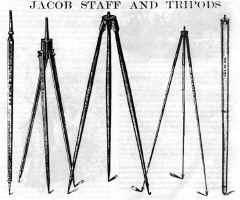|
 Article taken from "Backsights"
Magazine published by Surveyors Historical Society
Article taken from "Backsights"
Magazine published by Surveyors Historical Society
|
 Article penned by David G.
Krehbiel, as published in The Ontario Land
Surveyor, Spring 1990 (copyright POB Publishing Company, Canton, Michigan).
Article penned by David G.
Krehbiel, as published in The Ontario Land
Surveyor, Spring 1990 (copyright POB Publishing Company, Canton, Michigan).
When you hear the term Jacob (or Jacob's) staff, you probably have a mental
image of a single pole used to support a compass. However, the original Jacob's
staff was actually a surveying instrument developed in the 1300's that was used
in making nautical and astronomical measurements.
The original Jacob's staff, or cross-staff, was a single pole device credited
to Levi ben Gerson (1288-1344), who was one of the leading Jewish mathematicians
of the 14th century.
The pole was marked in degrees, and the altitude of the stars could be
determined by using a sliding wooden panel on the rod.
The American version of the Jacob's staff seems to have only borrowed the
name. Its function, as we know it, was to provide support for the compass.
In a manufacturer's catalog from the 1880's, the surveyor's compass is
described as being fitted to a slightly conical spindle with a spherical ball on
its lower end. The ball is confined in a socket by pressure so slight that the
ball can be moved in any direction in the operation of levelling the compass.
The spindle and the ball-and-socket are part of the brass head of the Jacob
staff. The brass head and a shoe, pointed with steel, were the mountings that we
sold to make up the Jacob's staff.
The catalog suggests that the staff itself, to which mountings securely
fasten, could be procured from a wheelwright or selected from a sapling in the
forest.
The 1880's catalog had the following listing:
Staff mounting, brass head (without spindle) $2.50 plus $0.18 postage
Staff mounting, steel point $0.60 plus $0.18 postage
While the tripod was in existence during the same period, the Jacob Staff was
often preferred because it was lightweight and less bulky than the tripod.
However, there was a compromise in accuracy with the Jacob staff, and there were
areas where soil conditions limited or prohibited its use.
There are probably fewer Jacob staffs to be found today than compasses or
chains. This is because there were only a limited number originally sold, and
some were no doubt discarded when the surveyor acquired a tripod. Also, if the
Jacob staff was separated from the brass head and shoe, it may not have been
recognized as part of a surveyor's outfit.
